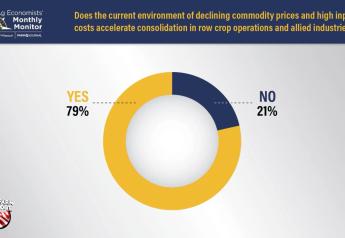Three Micronutrients with Macro Impact

Gone are the days of planting soybeans and simply leaving them to do their own thing. Management is critical when every bushel counts, and in-season management decisions can add or subtract around eight bu. per acre.
“In-season management practices at your disposal are limited, but there are some,” says Ross Bender, agronomist at The Mosaic Company. “Keep your field clean of weeds, keep insects at bay, keep plants healthy with fungicide and make sure fertility matches yield potential.”
You understand weed management, insect management and fungicides well enough—but fertilizing soybeans? That might be somewhat foreign since corn is usually the focus of fertility. Soybeans fix their own nitrogen, but other macro and micronutrients present or absent in your soil greatly impact your yield.
Mind micronutrients to make sure soybeans get what they need. “There are 17 essential nutrients, macronutrients are what you need in large quantities—N, P, K,” Bender says. However, don’t discount the importance of micronutrients, he adds. They’re needed at different points in the season, and some micronutrients work in conjunction with macronutrients such as sulfur with nitrogen.
Use tissue tests in addition to soil tests to find out what your soybeans could be lacking mid-season so you can make corrective applications.
“Sulfur is an essential building block in chlorophyll development and protein synthesis,” says Wesley Haun, agronomist with Tiger-Sul. “Sulfur is required by the rhizobia bacteria in legumes (such as soybeans) for nitrogen fixation.”
Without sulfur, soybeans might not create as much nitrogen as they need to thrive. Haun says soybeans need about as much sulfur as they do phosphorus—a macronutrient. Watch for sulfur deficiencies in sandy soils or soils with low organic matter.
“Soybeans require 20 to 25 pounds of sulfur per year,” according to Pioneer research. “Ammonium sulfate, ammonium thiosulfate, gypsum, potassium sulfate, magnesium sulfate and elemental sulfur are potential sources of supplemental sulfur.”
Boron can leach as easy as sulfur or nitrogen, Bender advises.
“Boron is likely to be deficient in coarse-textured and organic soils due to leaching losses,” says Mike Staton, Michigan State University Extension agronomist. Boron availability declines in basic soils from 6.5 to 8.0—these soils are where you’re most likely to see yield response from boron, he adds.
When you take a tissue sample look for 25 ppm to 60 ppm—any less and you could start seeing visual symptoms of boron deficiencies. This micronutrient is important because it helps with cell production, balances sugars and starches in plant cells, influences nitrogen metabolism and protein formation and helps manage water.
Boron is available in both liquid and granular forms—and either source can be effective when used in the right way and at the right time.
“To avoid leaf burn, foliar boron application rates should be less than 0.5 pounds per acre and do not spray when temperatures are high and the crop is under stress,” Staton says.
Bender has found dry applications of boron to also be successful in-season, especially when fertilizer sources are used which ensure the boron is uniformly distributed to every plant.
Finally, watch for zinc deficiencies because without it growth and development stops, according to research at Michigan State University. Zinc drives many metabolic responses in soybeans and zinc deficient plants have reductions in carbohydrate, proteins and chlorophyll formation.
Zinc is created with organic matter is mineralized, so conditions that slow this process increase your risk of a deficiency. Anytime you have cold weather or conditions that cause root growth to slow down plants might not have access to the zinc they need. Additionally, excessive phosphorus application can cause zinc deficiencies—more than 200 pounds of P2O5 per acre, according to Michigan State.
There are several sources of zinc: zinc sulfate, zinc-ammonia complex, zinc oxide and even certain kinds of manure. While in-season foliar applications of zinc haven’t always proven to be effective in correcting deficiency, they are possible. Mix zinc powders with water and apply it to leaf tissue. Michigan suggests 0.5 to 1.0 lbs of zinc per acres with a rate of 20 gallons of water, but advises to do it on a trial basis at first.
These three micronutrients have close relationships with the macronutrients soybeans need to survive. Use tissue sampling to know what you have and take corrective action in-season.







